Yoga
A journey of a million miles begins with a single step.
Welcome to the practice of yoga. Let’s begin a wonderful journey of discovery into your body and yourself that will help you find your fullest potential physically, mentally, emotionally, and spiritually.
Anyone can benefit from the practice of yoga. People of all ages, backgrounds, cultures, and religions come to yoga. Some are in great health; others come with injuries or physical limitations. Yoga is not only what happens during the pose but also what happens before and after the pose.
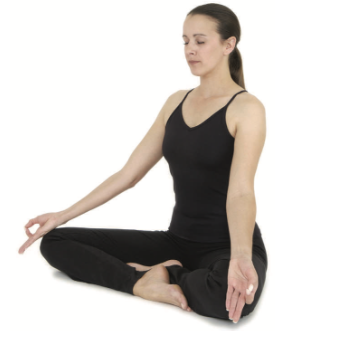
There is a force within the river that can guide us on our spiritual journey, the strength of grace.
Art and Practice of Hatha Yoga
Breathing we increase our sensitivity to the flow of energy, and with that increased sensitivity we are closer to realization of our own divine nature. The breath has the capacity to open the body and allow our energy to flow more freely in our yoga practice. Awareness of breath brings a mindful, sacred quality to an asana practice. Breathing, can bring you to a state of peace and relaxation.
The Natural Breath
The natural breath wants to flow in us as the fullest possible expression of the Shakti energy.
When to Practice
Important regular practice and consistent, more practice you will progress. Allow yourself 2 days off per week give your body time to recover as needed.
You should not practice yoga when you have a fever, cold or flu. Yoga raises the body temperature and competes for the energy your body needs to recover. Women should avoid doing inversions such as headstand or shoulder stand when they are menstruating. This is because the healthy downward flow of the menses is disrupted if a woman inverts during this time.
Always seek the advice of your physician and your yoga instructor about practicing if you are ill or injured.
Positions for Meditation
The Classical position for meditation is sitting on the floor in a cross-legged position.

Mudras
A mudra is a hand gesture, an asana for the hands. The most commonly recognized mudra is the “prayer” mudra, known to yogis as anjali mudra. Anjali means “offering”—this mudra can represent offering to oneself in service or in gratitude.
This will serve as your own personal guide along your yoga adventure. Enjoy your journey.
Standing Postures = are the most fundamental class of all asanas because they create the foundation for your practice by laying the groundwork. They help you increase power, strength, and stability in the legs. They aid in proper digestion, circulation, mobility, and spatial awareness. During a series of standing postures, the heart and lungs actively detox the blood. Following standing postures, the nervous system is better insulated, therefore leaving you feeling refreshed, attentive, and settled.
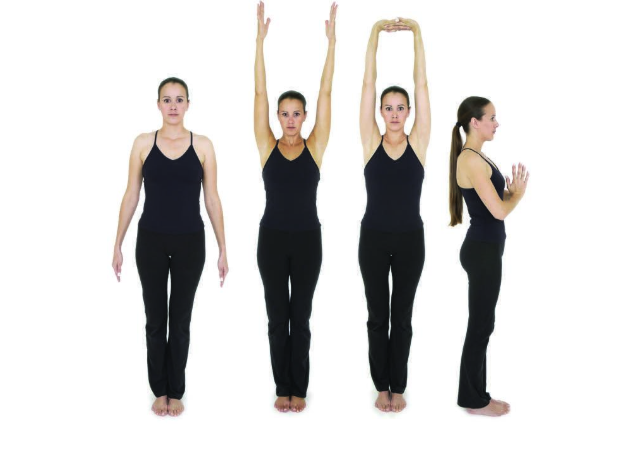
Mountain
Tadasana
Make sure your knees face directly ahead; adjust your feet slightly if necessary.
Hug your leg muscles to the bone on all sides by engaging the muscles from skin to muscle and muscle to bone; pull the muscles up from your feet into your pelvis.
Stand with your feet parallel. Draw an imaginary line from the centre of your ankle through the second toe of each foot and make those lines parallel to each other.
Lengthen the sides of your body, take your shoulders back, and bring the shoulder blades more onto your back.
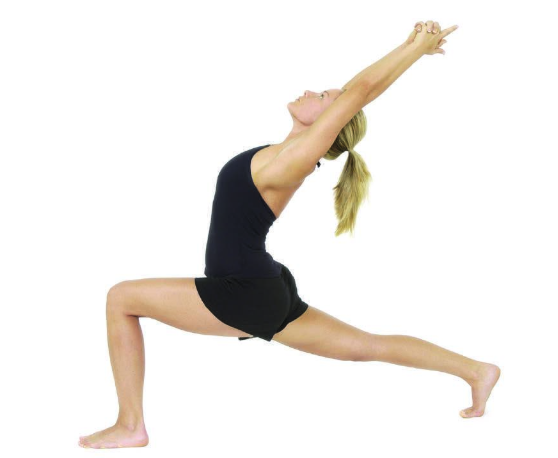
Drishti – focus gaze or sight – concentration
- Aligns the spine, tines abdominal muscles, open chest. Stretches arches, ankles, buttocks, improve posture, mental benefits, focus, reduce mild anxiety.
Downward-Facing Dog
Adho Mukha Svanasana
Line up the creases of your wrists so they are parallel with the front of your mat (or if not using a mat, with where your mat would be).
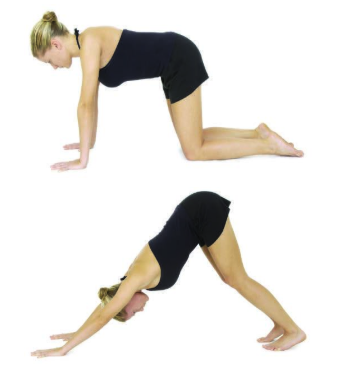
Keeping the toes spreading, root from your tailbone down through your legs to bring your heels toward the floor, then scoop your tailbone down, drawing your low belly in and up.
Perform a Lunge with your back knee down. Intense Side-Stretch.
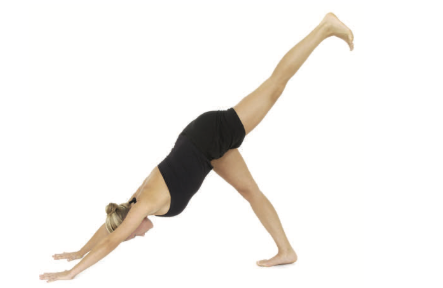
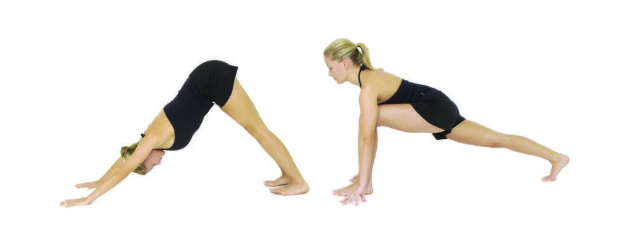
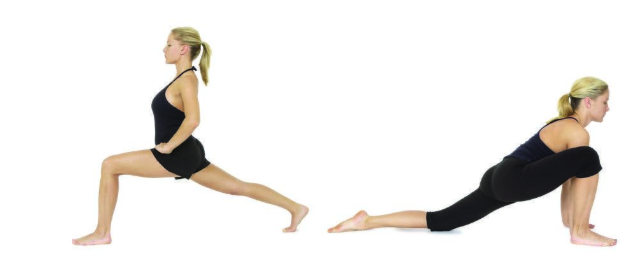
Downward-Facing Dog (Adho Mukha Svanasana)
- Strengthens the ankles, calves, knees, and thighs
- Relieves symptoms of sciatica
- Opens the hips and groin
- Increases lung capacity
- Alleviates symptoms of arthritis
- Lengthens the spine Improves digestion
- Builds focus Develops willpower Stimulates the mind Reduces stress
- Contraindications /Knee injury /Low blood pressure (keep fingertips upward, toward the ceiling)
Balancing Postures
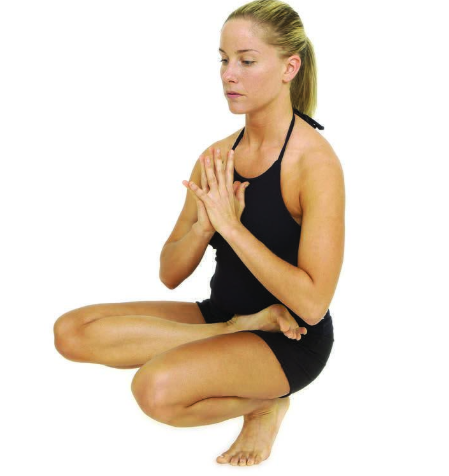
Balancing postures require a great deal of focus, strength, and stamina. They develop poise, agility, coordination, and concentration. They require you to draw into your core muscles and thus, your inner awareness. They are strengthening poses in which muscle tone is created and precise alignment is essential. Regular practice of the balancing postures shown in this chapter helps you develop increased control over your body.
Eagle
Garudasana
1 Stand in Tadasana
2 Balance on your left leg with your knee slightly bent. Lift your right leg and cross it over your left leg at the knee.
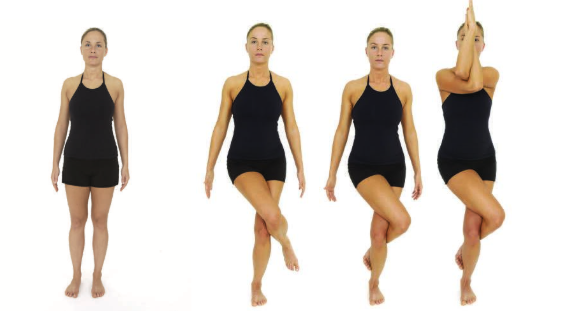
Hook your right foot behind your left shin, hugging your legs together.
Draw the top of your foot into your leg for stability.
Cross your left elbow over your right and join the palms of your hands.
Hug your legs together.
Keep the knee of your stand- ing leg bent.
Lift your elbows and extend from your elbows through your fingers.
Squeeze the muscles of the standing leg on all sides.
5 Hold for several breaths, come out of the pose and repeat on the other side.
Vrksasana
Stand in Tadasana
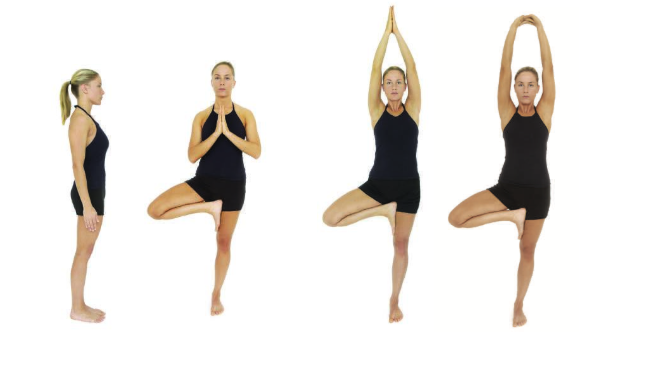
Hug the foot and thigh together.
Take the tops of your left thigh back, lengthen your tail- bone down, and extend from the core of your pelvis through your left leg into the ground.
Spread your toes and root down through all four corners of your feet. Inhale and draw muscular from your feet up into the core of the pelvis and hug your legs together. Focus on a point in front of you. Keeping your left leg strong and steady, inhale, bend your right leg and place the right foot against the inner left thigh. Bring your palms together in front of your heart. Inhale, lengthen the sides
of your body from the hips up to the shoulders and bring your shoulder blades onto your back. Extend your arms over your head beside your ears and bring your palms together. Hold for several breaths then lower the arms and leg simul- timeously. Repeat on the other side. Keep the arms fully engaged and straight.
Start in Downward Facing
Lateral Inclined Plane
Vasisthasana
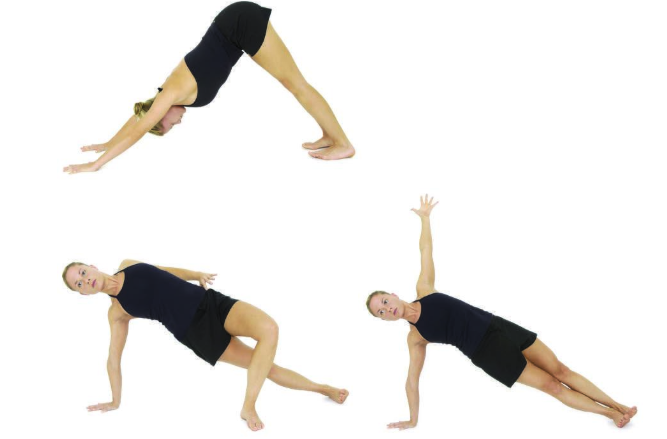
Keep your right leg engaged and your hips lifted.
Keeping your right arm at a right angle to your torso, spread your fingers, press your knuckles down, and draw up from back of your right wrist to your shoulder.
Spread your toes and keep your ankle square (the foot is at a right angle to your leg and the inner and outer ankle are the same length).
Bring your right hand to the left along the mid- line of your body and creating a right angle with your torso. Balance on the outer edge of your right foot. Bend your left knee and place your left foot on the floor in front of your right leg. Stack your left foot on top of your right foot and extend your left arm up.
Lengthen from your tailbone downward through your feet. Lengthen from your low belly up through the top of your head. Turn to look up toward the fingers of your left hand. Remain in the pose for a few breaths. Exhale and bring your arm down and transition through Down- ward-Facing Dog repeating the pose on other side.
Crane – Plow
Halasana
1 Lying flat on the floor, extend your legs verti- cally by bending your knees toward your chest and then extending your feet toward the ceiling.
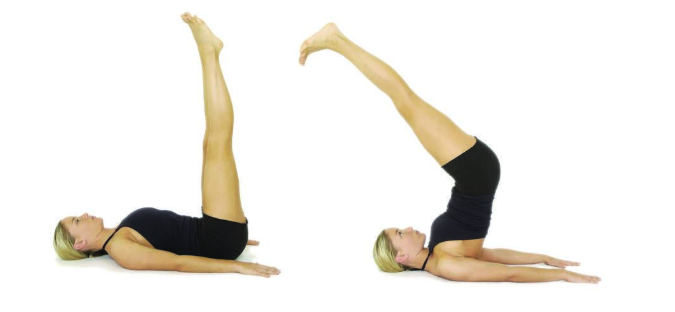
Inhale deeply, press your hands into the floor, and swing your legs forward over your head.
Bring your toes to the floor and keep your hips above your shoulders. Stay in the pose for several breaths. Using your hands for support, slowly roll onto your back and come out of the pose.
Corpse (Savasana)
Drishti
- Relieves fatigue in the legs and feet
- Prevents edema and varicose veins
- Soothes the nervous system /increase circulation
- Relieves mild backache, headache, and insomnia
- Relieves symptoms of arthritis /Alleviates urinary and respiratory disorders
Contraindications /Glaucoma/Serious neck or back injury
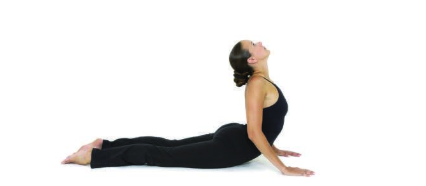
Keeping your neck long, slide the sides of your throat back and curl your neck to look up.
5 Hold for a few breaths. Exhale, release, and rest on your belly.
gentle Variation
Follow steps 1 through 3. Keep your forearms on the floor.
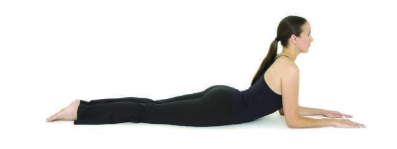
Upward-Facing Dog
Urdhva Mukha Svanasana
Lie on your belly.

Bend your arms and slide your palms back until your lower arms are perpendicular to the floor. Inhale and lengthen the sides of your body shrugging your shoulders up towards your ears. Lift your shoulders up away from the floor and bring your shoulder blades more onto your back behind your heart.

Lengthen your tailbone down toward your feet.
Spread your toes and press your toenails into the floor.
Camel
Ustrasana
1 Kneel on the floor with your thighs parallel
and rest your palms on your hips.

Lift your heart up to the sky and curl your shoulders back.
Rooting the tailbone down, bring your pelvis forward.
Press your shins into the floor. Inhale and extend from your pelvis through your head. Exhale and reach back to place your right hand on your right heel. Repeat with your left hand. Keep your neck elongated and slide the sides of your throat straight back. Maintaining the length in your neck curl your head backwards.
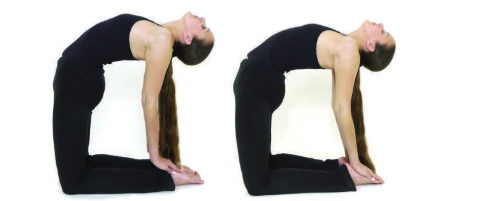
Slide your hands down to the soles of your feet. Remain in this position for a few breaths. Exhale, powerfully root down through your shins into the floor, and lift from behind your heart and keep your head back as you come up. Rest by sitting back on your heels for a few breaths.
Bridge
u Banda Sarvangasana
Lie on your back.

Lengthen the sides of the body, press your shoulders down to the floor, and bring your shoulder blades more onto your back. Press your sitting bones down into the floor to create a natural curve in the low back.
Bend your knees and place your feet parallel to each other and hip-width apart.
Keeping the sides of your body lengthened, roll both shoulder blades more deeply onto your back.
Press your hands and arms down to create lift in the hips. Inhale, press your feet into the floor, and lift your hips. Lengthen your tailbone and extend from your pelvis out through your knees. Clasp your hands together under your back and roll your right and left shoulders underneath one at a time, drawing your shoulder blades more onto your back.
Press your heels down and pull back with your feet toward your shoulders to engage the hamstrings.
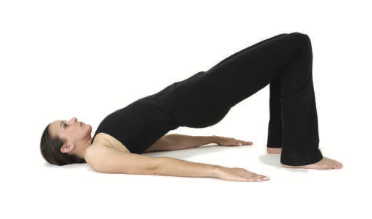
Dhanurasana
Lie on your belly.
Spread your toes and press through the ball of the big toe.
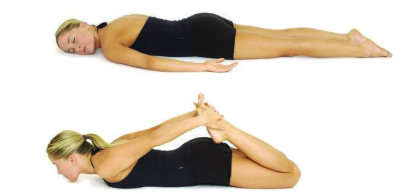
Rest your chin on the floor. Inhale, bend your knees, and hold of the tops of your feet.
Extend from your pelvis out through the crown of your head, lengthening your spine.
Draw your shins in and keep your thighs parallel. Only your belly stays on the floor.
Inhale, press your knees into the floor, and lift your hips up. Exhale and scoop your tailbone, extending outward toward your knees. Inhale again and lengthen the sides of your body from your hips to your armpits. Exhale and draw your shoulder blades onto your back behind your heart, press your feet powerfully into your hands, and lift your legs and torso off the floor. Hold the pose for a few breaths. Exhale, lower your knees, release your hands, and rest on your belly.
Keep your thighs parallel.
Inhale and lift your chest, head, arms, and legs off the floor.

Urdva Dhanurasana
Lie on your back.

Matsyasana
Sit with your legs folded in the Lotus pose (see page 156).
Lean your torso back and rest on your elbows.
Lengthen from your
pelvis out through Lift your chest upward. your knees.
Lower your shoulders and the back of your head to the floor. Bring your arms out straight by your sides.
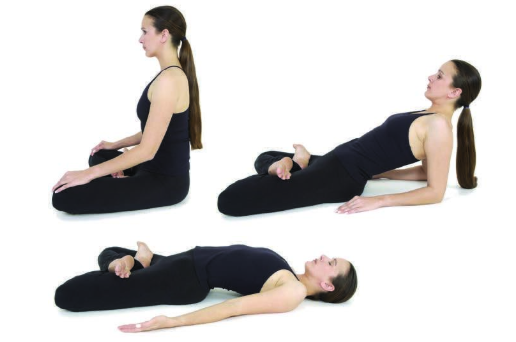
Inhale, press your elbows down, lift your chest, curl your neck back, and rest the top of your head on the floor. Hold the soles of your feet with your hands. Remain in the pose for several breaths. Come out of the pose by using your elbows for support to lower your back to the floor. Then use your elbows to bring yourself back up to a sitting position and release your legs.
Actively pull your feet and bring your shoulder blades more onto your back behind your heart. Lengthen your tailbone, stretch the front of your thighs, and extend from your pelvis out through your knees.
Press the back of your head into the floor and back toward your hips, deepening the arch of the back and coming more onto the crown of your head.

Cat–Cow
Point your feet straight back.
Keep your arms straight.

Come to all fours with your wrists directly underneath your shoulders and your knees under your hips. Inhale and lengthen from your hips up to your armpits. Spread your fingers and root down through your hands as you draw from the floor up into your shoulders. Bring the shoulder blades onto your back. Keep your hips and arms stable and move from your spine. Lift the sides of your waistline. Fully inflate from your lower back all the way through your upper back. Lower your head.
Exhale, press your hands into the floor, and round your spine up toward the ceiling. Tilt your pelvis down and scoop your tailbone. Inhale and move your spine in the opposite direction, creating concavity in the spine. Tilt your pelvis upward and lift your head. Repeat steps 2 and 3 for five to ten breaths. Push back into Child’s Pose and rest for a few breaths. Keep your hips directly over your knees. Maintain an even curvature in your spine.
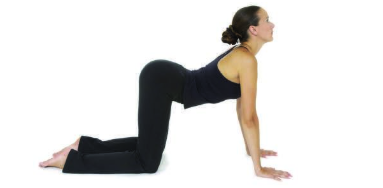
Keep your arms straight.
Twisting Postures
Twists are a unique class of postures because they are cooling and soothing after backbends yet stimulating after forward bends. In addition, they replenish the circulation to the spinal muscles and disks creating hydration and mobility. They squeeze the abdominal organs as the trunk rotates, allowing fresh blood to surge into organs following a twist.
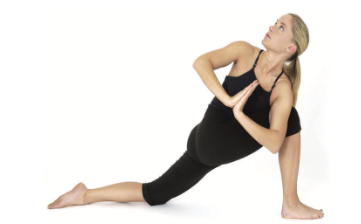
Over shoulder Eyes closed.
- Improves digestion and circulation /Reduces discomfort from backache, neck pain, and sciatica
- Stretches and strengthens the spine, shoulders, and hips
- Stimulates the lymphatic system
Spinal twist
Originate the twist in the core of your pelvis, spiraling the twisting action upward through the spine. The last part of the twist is your head turning to the right.
Press your left hand into your right knee for added leverage while twisting.
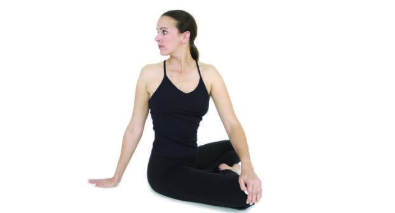
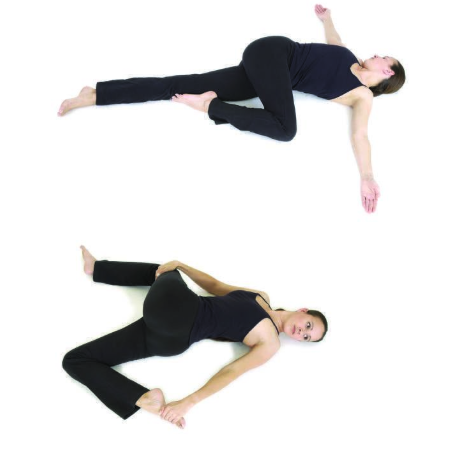
Lengthen up through the sides of the body. Draw your shoulder blades more onto your back to open the front of your chest.
Janu Sirsasana
Sit with your legs extended. Press your hands into the floor and lengthen your spine upward. Bend your right leg and move your knee out to the right. Place your right heel on the inner edge of your right thigh near the perineum. Rotate your left leg inward so that your knee and foot point straight up.
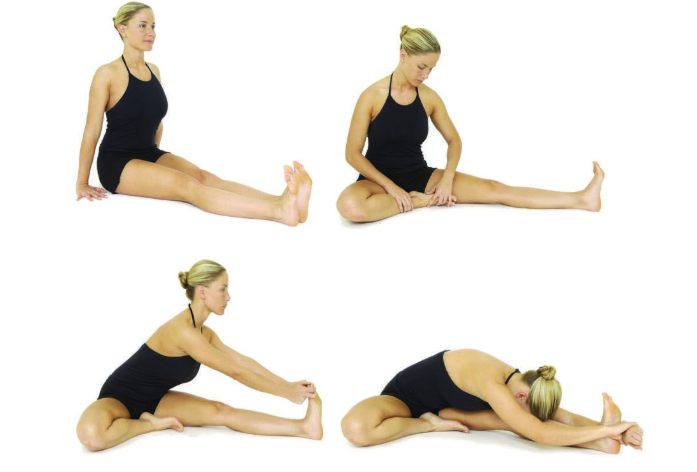
Turn your torso to face your straight leg and extend your arms forward, holding your foot with both hands. Inhale and lengthen from your pelvis up through your head. Exhale and extend forward over your left leg, leading with your heart. Reach your hands forward around your left foot. Widen your elbows out and draw your torso forward
Draw muscularly up your arms into your shoulders and bring your shoulder blades deeply onto your back. Tilt your sacrum forward, draw your low back in and up.
Firmly press your toes into the floor and hug your right ankle in toward your hip.
Bend your right leg and place your ankle by the side of your right hip. Point your right foot straight back. Manually widen your hip flesh to the sides and distribute your weight evenly between your right and left buttocks.
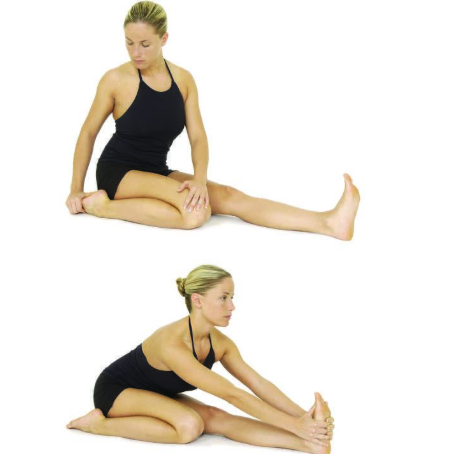
Extend your arms forward and hold the sides of your left foot with both hands. Inhale and extend from your low belly up through your head.
Exhale, widen your elbows out to the sides, and extend your torso forward, leading with your heart. Keep your left leg actively engaged and straight. If you are able to keep your spine extended, you can touch your head to your shin.

Sitting Postures
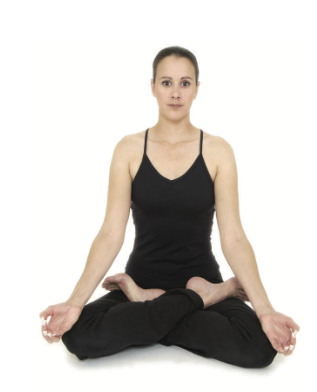
Baby Cradle
Sit with your legs extended. Press your hands into the floor to lengthen your spine. Inwardly rotate your right leg and extend from the core of your pelvis out through your foot.
Bend your left leg and draw your knee out to the side. Bring your hands underneath your leg, cradling your foot and lower shin.
Bring your left leg up and parallel to the floor.
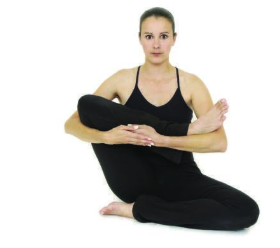
Relaxation Postures.
Relaxation poses soothe and balance the nervous system, offering the body rest from physical activity.
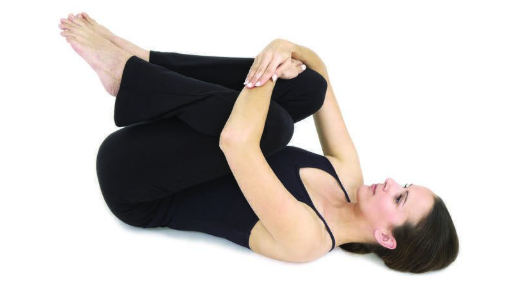
Apanasana
Lie on the floor with your legs extended. Point your feet and keep your toes together. Place your hands just below your knees. Bend your knees in toward your chest and separate your knees. Draw your knees together and wrap your arms around your legs. Roll to your right. Roll to your left. Repeat several times, then rest on your back or in Savasana.
- Promotes the health and function of the hip, knee, and ankle joints
- Stimulates thyroid and parathyroid productivity. Helps normalize high blood pressure. Calms the nervous system. Creates a feeling of grounding and stability Increases mental clarity Calms the mind.
Child’s Pose =Balasana
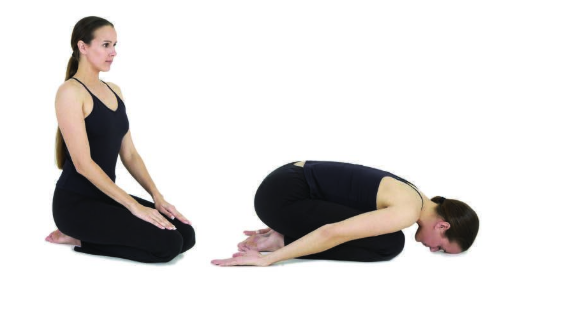
Sit on your heels with your shoulders above your hips.
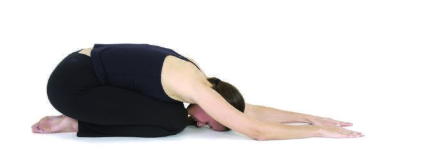
Rest your forehead on the floor, soften your face.
Bow forward and gently place your chest on your thighs. As an option, bring your arms forward. Walk your finger- tips forward and away from your shoulders.
Lengthen the sides of your body by extending from your hips to your shoulders.
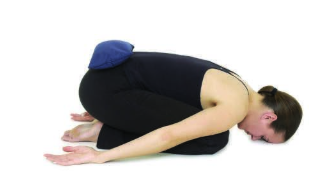
As an option, place a small sandbag or bolster on your low back. The pressure will relax your lower back muscles.
The prop should be heavy enough to feel, but light enough that it does not take away from your ability to relax and restore in the pose.
Savasana
Sit with your legs extended and your hands by your sides.
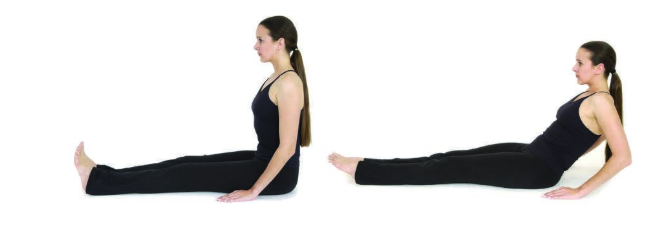
Legs remain straight. As you lean back, keep your spine straight.
Support yourself with your arms as you recline onto the floor.
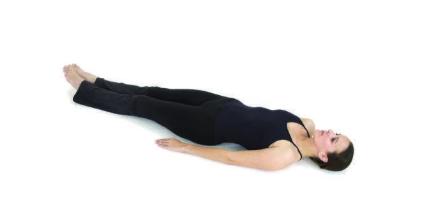
Lie flat on your back. Relax your legs and allow your toes to roll out toward either side of the body.
Relax all facial muscles and the muscles of your jaw. Rest the back sides of your shoulders into the floor, opening your chest.
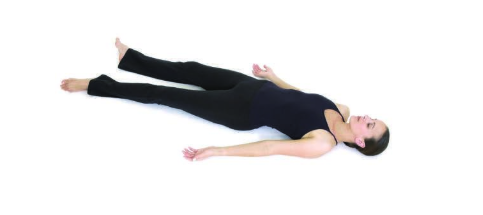
Well done, that is the end of the session
The session end.
Book a free discovery call with me today to discuss how Nutrition Living Naturally can help you.

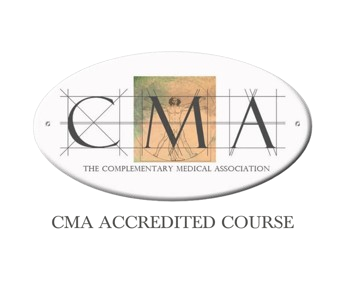


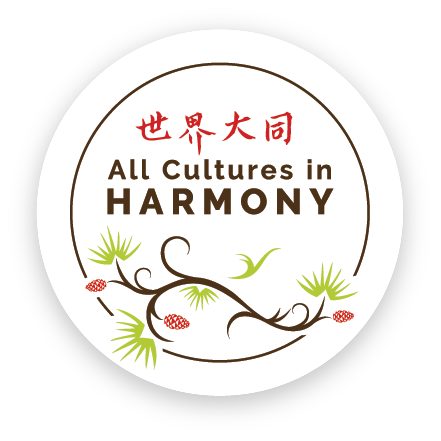

Nutrition Living Naturally
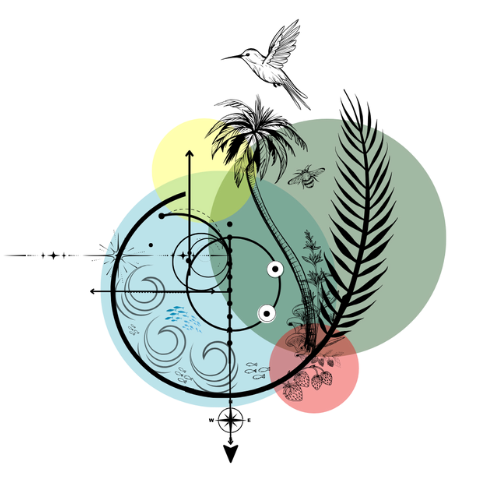
Nutrition Living Naturally. Registration Number ZB 644 329. UK.
